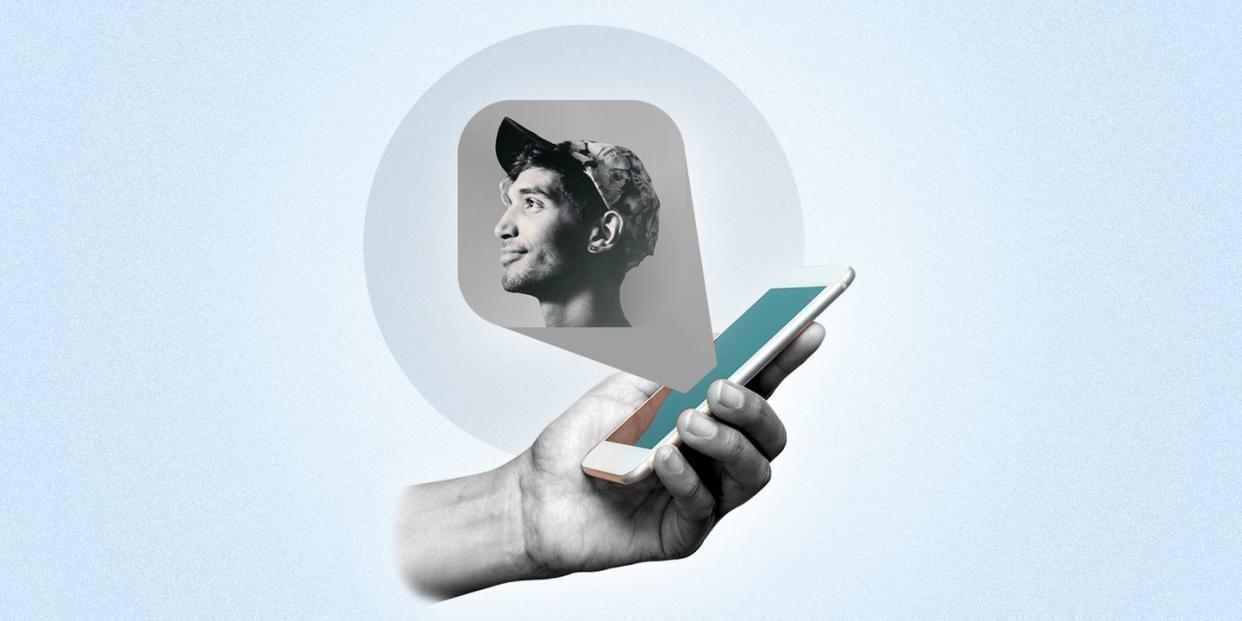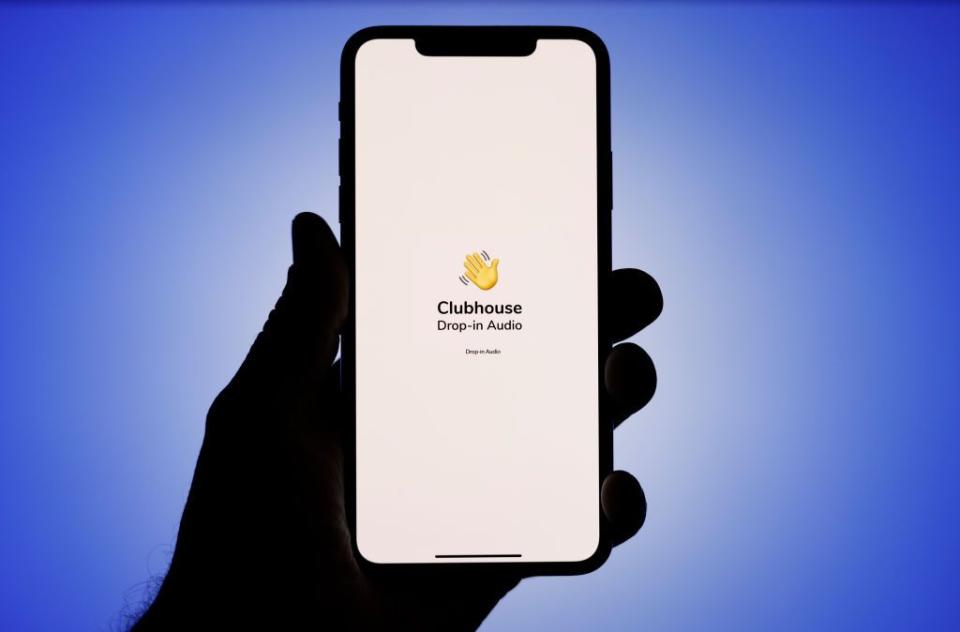Everything Worth Knowing About Clubhouse—And Its Many Audio Chat Copycats

It’s Tuesday night, and I’m listening as a stranger cries through my phone. I can hear her voice as it breaks, and I want to comfort her, though she doesn’t know me, and I don’t know her. We’re in a “room” together on the drop-in audio chat app Clubhouse that's hosted by comedian Dane Cook, a nutritionist, and a music video director. This room, like many others on the app, feels like some kind of Mad Libs fever dream, where even as I’m listening, my brain is fielding an influx of questions. I’m starved for context: Who is this person? What is her life like? Where is she in the world? And yet, I remain captivated by the simple impulse to witness this fleeting moment of connection, like leaning in to hear a secret.
This stranger had been in the Clubhouse audience, brought up to the virtual stage to ask a question about the theme of the evening: staying positive through hard times. Moments earlier, all of the 100-plus people in the chat room had heard a moderator's baby squeal in the background as the moderator talked. The stranger unmuted her microphone and introduced herself, thanking the hosts. Then the thin top layer of her voice cracked as she confessed that hearing the baby was the first thing that made her smile that day. She has been “so isolated,” she said.
It’s moments like these that soften me to Clubhouse, and make me wish it were as good a social media app as it could be. There is a peculiar intimacy in listening as a stranger’s voice streams out of your iPhone speaker, and even more so when the relative air of anonymity of a room of hundreds (or thousands) of silent witnesses lets people emit a degree of spontaneous vulnerability that they might not share on any other platform. It makes you want to believe in the goodness of people and their intentions.
But like anything else born of the internet and the tech world, the buzzy new app has its pitfalls and shortcomings—from data security, to accessibility and user experience concerns—which are worthy of a closer look. With Twitter and other platforms developing their own audio chat features in an attempt to rival the success of Clubhouse, the question now is: How did Clubhouse pull this off, and is it here to stay?
Why Clubhouse Blew Up
The first week of February, it seemed that everywhere you looked on the internet, someone was talking about Clubhouse. On February 1, Elon Musk went on Aarthi Ramamurthy and Sriram Krishnan’s "The Good Time Show" on Clubhouse, where he trolled Robinhood CEO Vlad Tenev over Robinhood’s shady decision to prohibit (and then limit) users from buying GameStop stock after r/WallStreetBets brought a hedge fund to the brink of bankruptcy. If you read that last sentence and thought, “I don’t know what half of these words mean,” congratulations. You likely have a healthier relationship with the internet than I do, and I am jealous.
Clubhouse was founded back in March 2020 by Paul Davison and Rohan Seth. Their goal was “to build a social experience that felt more human—where instead of posting, you could gather with other people and talk,” according to a post on the Clubhouse blog. When you open the app, you’re greeted by various rooms like “Marketing Masterclass” or “Want to MANIFEST *FAST*? WARNING: Not for Everyone!” with the names of speakers and audience members listed below. Click on a room, and you’re transported into the audience to hear the live conversation. In some rooms you can only listen, but in others you can raise your virtual hand and be brought up to the “stage” to join the conversation. By February 2021, the app had raised over $100 million in venture capital and was valued at $1 billion. It was, and remains today, in beta mode, available solely on iOS, and joinable by invitation only.

I joined a few weeks after Musk, having secured an invite from a tangential college classmate connection on Instagram; like the “weak ties” sociological theory of employment, it was a weak tie that got me into the exclusive party of Clubhouse. And like many exclusive parties, when I first got there, the excitement of being included outshone the actual gratification of the experience. It seemed like I was either too early or too late, never there at the right time.
This anxiety—the fear of missing out—is arguably the force that catapulted Clubhouse into the mainstream. The best moments on Clubhouse happen when you’re not there, and this keeps people coming back. Because tonight just might be the night you catch Justin Bieber in a room, making you feel like you’re on a conference call with the Biebs himself. Or maybe Mark Zuckerberg, Bill Gates, Lindsay Lohan, scam artist Anna Delvey, Julia Fox, Oprah, Drake, Ashton Kutcher, Tiffany Haddish, or Kevin Hart—the list of celebrity Clubhouse users goes on. Or you’ll wind up, as I did recently, listening to MC Hammer talk about the beauty of NFTs while you wash dishes.
Clubhouse is like Omegle’s chat roulette, but instead of dicks popping up in each new room, it’s an endless sea of hustlers, self-proclaimed millionaires, investors, entrepreneurs, artists, experts, life coaches, politicians, and celebrities. It’s the newest thing in social media and also the oldest. But the difference between call-in radio or conference calls and Clubhouse is serendipity, and the promise of authenticity in a live conversation that ends when it ends, like real conversations out in the world.
Clubhouse came at a time when people were especially craving somewhere to connect, to speak, to perform, to gossip. Performers needed virtual stages, and almost everyone needed to feel like they were living through a shared moment, to feel “in this together.” It was the perfect storm of mystery, exclusivity, camaraderie, and buzz. And with that storm, some of the issues brimming beneath the surface got swept away.
The Problems With Clubhouse
Although Elon Musk’s appearance generated a renewed public interest in Clubhouse, those paying attention know that Black creators have truly made Clubhouse what it is. By innovating new uses for the app (like Sydney Connors and Brandon Patterson’s virtual production of Dreamgirls, or musician Bomani X’s concerts), Black Clubhouse users brought more and more people into Clubhouse, creating exciting potential for a platform that could have easily been a boring soapbox for Silicon Valley tech bros. Clubhouse benefited from free Black labor, and beyond expressing its commitment to diversity in its team and investors, the app hasn’t been direct about any plans to compensate the many Black creators who defined its success.
However, on April 5, Clubhouse began rolling out its new tipping feature, which will let users send money directly to their favorite creators, with 100 percent of the funds going to the creator.

Join Esquire Select
Another troubling aspect of Clubhouse is its data collection. When you join the app, it asks for access to your contacts. It incentivizes you to share this information by only allowing you to invite friends if you share your contact list. If you say yes, it ranks your contacts in order of how many other Clubhouse users have that person in their contacts. As OneZero tech writer Will Oremus points out, this is distressing for multiple reasons; Clubhouse is collecting information on people who haven’t even consented to it, and it’s also revealing shared social links—like people who have the same psychiatrist or drug dealer—without all parties’ consent.
There has been data spillage as well, which isn’t too surprising. People record and stream rooms elsewhere on the internet, though it’s prohibited. And paradoxically, Clubhouse actually has to record the “live” conversations in order to safeguard against hate speech and abuse, which has been and continues to be an issue for the app. And in terms of accessibility, Clubhouse excludes deaf and hard-of-hearing people by design, with no word yet on auto-captions or other accessibility features.
Clubhouse Today—and the Competition
Founder Paul Davison addressed some of the data concerns in a town hall Clubhouse room last month, according to WIRED:
It’s also added some product features that users have been asking for, including link sharing and language filtering. The app also won’t require access to users’ phone contacts anymore, now, users can invite new people to the platform directly by using the person’s phone number. Davison said users can reach out to the company to delete previously-uploaded contacts, and that a tool to allow users to delete contacts from Clubhouse is coming soon.
Not all of these changes have been implemented yet, but they show a step in the right direction.
The top contender in the competition race for Clubhouse is Twitter Spaces, a new feature within Twitter that will allow users to host drop-in audio chats. This feature is rumored to launch this month, with caption capabilities and other features that Clubhouse doesn’t currently have. (Twitter even reportedly considered buying up Clubhouse.) Facebook, Spotify, LinkedIn, and Slack are also nosing around the audio chat space.
In the post-pandemic world, some aspects of Clubhouse—the ephemerality and the human connection—will likely wax and wane in terms of desirability. As more and more people can go out and see friends, coworkers, and family, they may not feel the same need to connect with strangers through audio-based social media. Some of the magic might slip away. But the rise of Clubhouse exposed the need for human connection at the most basic level, where anyone in the know can participate no matter where they are or what they're doing.
The mission to make social media a tool that can help us feel less alone, rather than even more isolated, is a noble one. Whether Clubhouse can stay ahead of the competition will hinge on its ability to adapt and keep that spark of genuine connection alive. Until then, it's just got to keep people talking.
You Might Also Like


